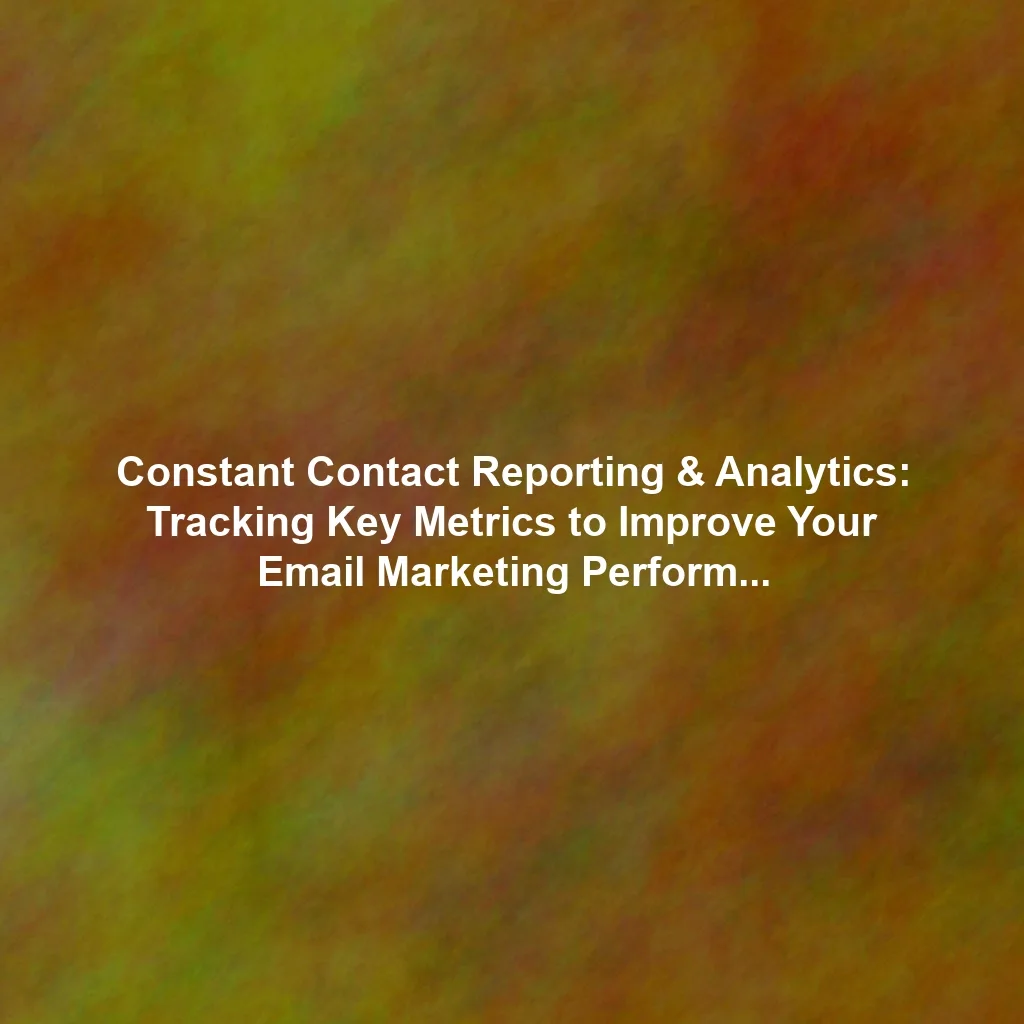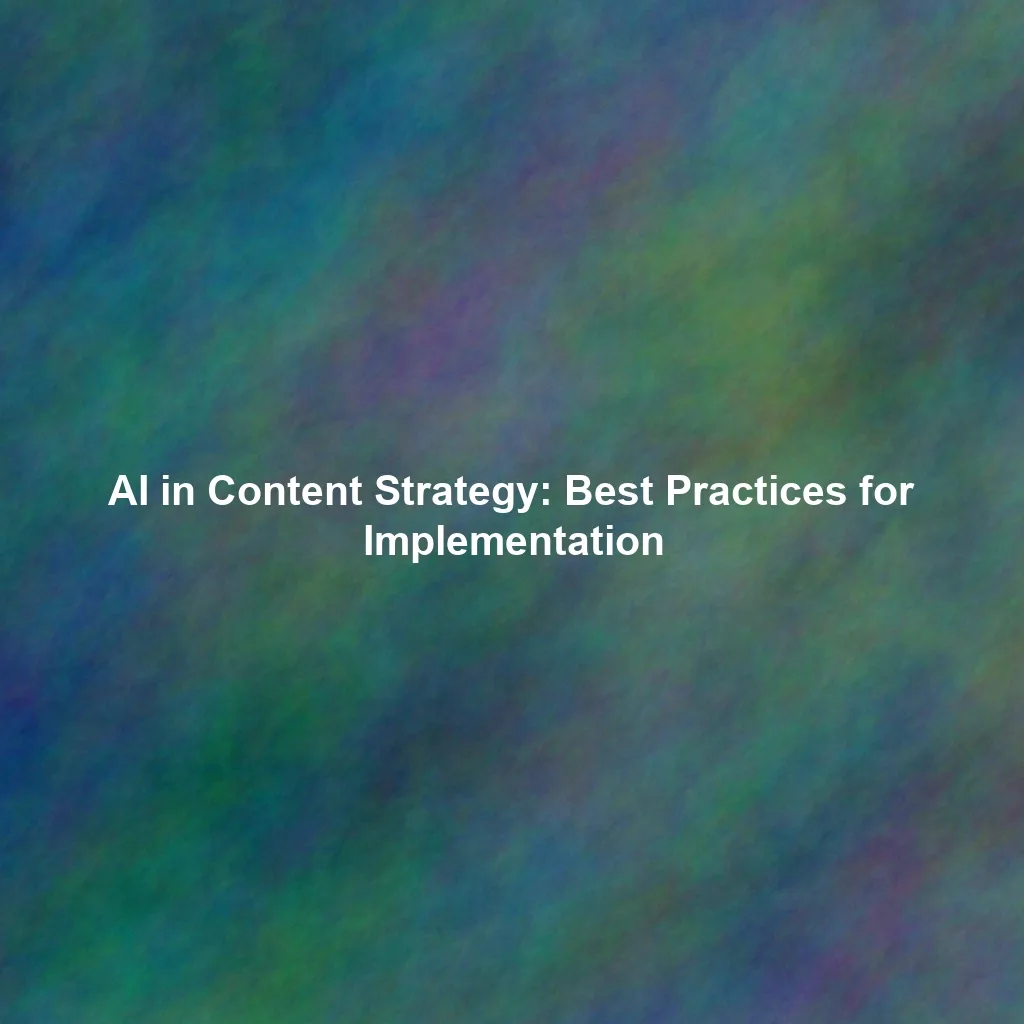This article will serve as your comprehensive guide to leveraging Constant Contact’s analytical prowess. We’ll delve into the essential metrics you must monitor, explain how to interpret the nuanced stories these numbers tell, and provide actionable strategies to continuously refine your email marketing efforts. The goal is to transform your email campaigns from mere broadcasts into highly optimized, revenue-generating powerhouses.
Understanding the Strategic Power of Constant Contact Reporting and Analytics
Constant Contact is more than just an email sending platform; it provides a comprehensive suite of analytics tools that empower you to monitor the performance of your email campaigns in real-time. These insights are not just numerical summaries; they are invaluable intelligence for making precise, data-driven decisions and continually refining your approach. Without this analytical backbone, your email marketing efforts would be akin to sailing without a compass – you might be moving, but you won’t know if you’re heading in the right direction or how to adjust your course. The strategic importance of these reporting capabilities cannot be overstated:
- Justifying Investment: Demonstrating the ROI of your email marketing efforts to stakeholders and securing future budget allocation.
- Optimizing Performance: Identifying what content, subject lines, and calls to action resonate most with your audience.
- Improving Deliverability: Pinpointing issues that might prevent your emails from reaching the inbox.
- Enhancing Segmentation: Understanding how different audience segments respond to various messages.
- Personalizing Experiences: Gathering data that informs more personalized and relevant future communications.
- Competitive Advantage: Staying ahead by continuously learning from your own data and adapting faster than competitors.
Key Email Marketing Metrics in Constant Contact: Your Analytical Compass
To effectively measure the success of your email marketing campaigns within Constant Contact, you need to focus on a core set of Key Performance Indicators (KPIs). These metrics provide a holistic view of your campaign health, audience engagement, and conversion effectiveness:
1. Open Rate: The First Impression Metric
The Open Rate is the percentage of recipients who opened your email. This metric is your primary indicator of how effective your subject line is at grabbing attention and how relevant your sender name appears to your audience. A high open rate suggests your subject line is compelling, your audience recognizes and trusts your sender, and the email content is perceived as valuable even before opening. Conversely, a low open rate signals a need for immediate attention to these critical “first impression” elements.
2. Click-Through Rate (CTR): The Engagement Barometer
The Click-Through Rate (CTR) is the percentage of recipients who clicked on at least one link within your email. This metric is a direct reflection of the engagement level with your content and the effectiveness of your call to action (CTA). A strong CTR indicates that your email content is compelling enough to drive action, your message resonates, and your CTAs are clear and enticing. It’s a vital measure of how well your email is moving recipients further down your marketing funnel.
3. Bounce Rate: The Deliverability Health Check
The Bounce Rate is the percentage of emails that couldn’t be delivered to the recipient’s inbox. Monitoring this is crucial for maintaining a healthy sender reputation and ensuring your emails actually reach their intended audience. Constant Contact typically categorizes bounces into two types:
- Hard Bounce: Indicates a permanent delivery failure. This usually means the email address is invalid, doesn’t exist, or has been permanently blocked. These addresses should be immediately removed from your list to protect your sender reputation.
- Soft Bounce: Indicates a temporary delivery issue. This could be due to a full inbox, a server being down, or the email being too large. Soft bounces may eventually be delivered, but persistent soft bounces from the same address warrant investigation.
High bounce rates, especially hard bounces, can severely negatively impact your sender reputation with Internet Service Providers (ISPs), leading to your emails being flagged as spam or blocked entirely. For more on email deliverability, consult resources from Mailgun or other email service providers.
4. Unsubscribe Rate: The Relevance Indicator
The Unsubscribe Rate is the percentage of recipients who opted out of your email list after opening a specific email. While some unsubscribes are unavoidable (people change jobs, interests evolve), a consistently high unsubscribe rate can signal underlying issues with your content’s relevance, the frequency of your emails, or your initial audience targeting. It’s a critical feedback mechanism indicating that your current strategy might not be meeting subscriber expectations.
5. Spam Complaints: The Reputation Red Flag
Spam Complaints represent the number of recipients who marked your email as spam. This is arguably the most critical metric to monitor, as even a small number of spam complaints can severely damage your sender reputation with ISPs. High spam complaint rates can quickly lead to your emails being blacklisted, resulting in significant deliverability problems and a drastic reduction in your email marketing effectiveness. It’s a strong signal that your audience perceives your content as unsolicited or irrelevant, often due to poor segmentation, misleading subject lines, or purchasing email lists.
6. Conversions: The Ultimate ROI Metric
Tracking Conversions is paramount for understanding the ultimate ROI of your email marketing efforts. This involves monitoring the number of recipients who completed a desired action after clicking a link in your email. This could be making a purchase, filling out a lead generation form, downloading an e-book, registering for a webinar, or signing up for a service. Constant Contact can integrate with your website analytics (e.g., Google Analytics) or e-commerce platforms to help attribute these conversions directly back to your email campaigns, providing a clear picture of their revenue impact.
Anecdote: The Small Business’s Subject Line Breakthrough
Sarah, who runs a local bakery, was frustrated by her low email open rates in Constant Contact. “I was spending so much time writing these newsletters, and no one was even seeing them!” she lamented. Her Constant Contact reports showed consistent 15% open rates. After attending a Constant Contact webinar on subject line best practices, she started A/B testing. Instead of “Weekly Bakery News,” she tried “Warm Croissants & Coffee: Your Weekend Treat Awaits!” or “Don’t Miss Our New Sourdough!” Within a month, her open rates jumped to over 30%, and her sales saw a noticeable bump. “It was a small change, but the data showed it made all the difference,” she said, highlighting the power of granular optimization.
Interpreting Your Constant Contact Data: What the Numbers Truly Tell You
Simply tracking metrics is a good start, but it’s only half the battle. The real value lies in understanding what these numbers mean in context and how they relate to your overall marketing strategy. This interpretation phase is where data transforms into actionable insights.
Analyzing Open Rates: Beyond the Percentage
A consistently low open rate (relative to industry benchmarks or your past performance) might indicate issues with:
- Subject Line Effectiveness: Is it compelling, concise, and relevant to your audience’s immediate needs or interests? Is it creating enough curiosity without being misleading? Try A/B testing different subject line approaches (e.g., questions, urgency, personalization, emojis) to see what resonates best with specific segments.
- Sender Name Recognition and Trust: Is your sender name instantly recognizable and trustworthy? Use a consistent, professional sender name that your audience will immediately recognize as your brand. Avoid generic “no-reply” addresses.
- Optimal Sending Time: Are you sending emails at the optimal time for your specific audience? Constant Contact provides insights into when your audience is most active. Experiment with different send days and times to see when you get the highest open rates. Consider time zones if your audience is geographically dispersed.
- List Segmentation and Relevance: Are you sending relevant content to the right segments of your audience? Sending generic emails to a diverse list often leads to low engagement. Segmenting your list based on demographics, interests, past behavior, or purchase history can significantly improve open rates by ensuring content relevance.
- List Hygiene: A list filled with inactive or invalid email addresses will naturally depress your open rates. Regular list cleaning is essential.
Boosting Click-Through Rates: Driving Action
A low CTR, even with a decent open rate, might suggest problems with the content itself or the call to action:
- Content Relevance and Value: Is your email content genuinely engaging, valuable, and aligned with the expectations set by your subject line? Does it solve a problem, provide useful information, or offer an enticing benefit? Make sure your content aligns with your audience’s interests and needs, moving them towards the next step.
- Call to Action (CTA) Clarity and Compellingness: Is your CTA clear, concise, and compelling? Use strong action verbs (e.g., “Shop Now,” “Learn More,” “Download Your Guide”). Is it visually prominent and easy to find? Ensure there’s a single, primary CTA to avoid confusing recipients.
- Email Design and Readability: Is your email visually appealing, uncluttered, and easy to read on all devices? Use a responsive design that adapts seamlessly to different screen sizes (desktop, tablet, mobile). Avoid overly dense text blocks.
- Link Placement and Prominence: Are your links strategically placed within your email? Are they easy to find and click on (especially on mobile devices)? Don’t bury your links; make them obvious and accessible.
- Value Proposition: Is the value proposition of clicking clear? What will the recipient gain by taking the next step?
Reducing Bounce Rates and Spam Complaints: Protecting Your Reputation
These metrics are crucial for your sender reputation and long-term deliverability. To minimize bounce rates and spam complaints:
- Clean Your List Regularly: Implement a regular schedule for list hygiene. Remove inactive subscribers, hard bounces, and invalid email addresses. Constant Contact often automates some of this, but manual checks are still beneficial. Consider re-engagement campaigns for inactive subscribers before removal.
- Utilize a Double Opt-In Process: For new subscribers, require them to confirm their subscription via a follow-up email. This ensures that only genuinely interested individuals are added to your list, significantly reducing hard bounces and spam complaints.
- Provide an Easy Way to Unsubscribe: Make your unsubscribe link prominent and easy to find in every email. While it might seem counterintuitive, making it difficult to unsubscribe often leads to frustrated recipients marking your email as spam instead.
- Comply with Regulations: Ensure all your emails comply with relevant anti-spam regulations, such as the CAN-SPAM Act in the US, GDPR in Europe, and CASL in Canada. This includes clear sender identification, physical address, and an easy unsubscribe mechanism. For CAN-SPAM details, see the FTC’s compliance guide.
- Authenticate Your Email: Implement email authentication protocols like SPF (Sender Policy Framework), DKIM (DomainKeys Identified Mail), and DMARC (Domain-based Message Authentication, Reporting & Conformance). These technical configurations verify that your emails are legitimately coming from your domain, significantly improving deliverability and reducing the likelihood of being flagged as spam.
- Avoid Purchased Lists: Never, under any circumstances, use purchased or rented email lists. These lists are notorious for high bounce rates, spam complaints, and will severely damage your sender reputation.
Leveraging Conversions: The Bottom Line
Conversions are the ultimate measure of success for most marketing campaigns. To maximize them:
- Optimize Landing Pages: Ensure the landing pages your emails direct subscribers to are highly optimized for conversion. They should have a seamless transition from the email, a clear and consistent message, a prominent CTA, and a streamlined path to conversion.
- Track End-to-End: Use Constant Contact’s tracking capabilities in conjunction with your website analytics (e.g., Google Analytics) to track the entire customer journey from email click to final conversion. This helps you understand which email campaigns are most effective at driving your desired outcomes and contributing to revenue.
- Assign Value: If possible, assign a monetary value to each conversion (e.g., average purchase value, lead value). This allows you to calculate a true ROI for your email marketing efforts.
Anecdote: The Non-Profit’s Donation Surge
The “Green Earth Alliance,” a non-profit, used Constant Contact to send fundraising appeals. Their unsubscribe rates were creeping up, and donation conversions were flat. Their marketing coordinator, David, noticed in the reports that appeals sent to their entire list were underperforming. He segmented their list into “Past Donors,” “Volunteers,” and “Newsletter Subscribers.” He then crafted highly personalized appeals for each, referencing past contributions for donors, and specific volunteer opportunities for that segment. The next campaign saw a 20% drop in unsubscribes and a 15% increase in donations. “Segmentation and personalization, driven by Constant Contact’s data, made our appeals resonate so much more,” David explained. “It felt less like a mass ask and more like a personal conversation.”
Actionable Tips and Strategies for Supercharging Email Marketing Performance with Constant Contact
Beyond interpreting metrics, proactive implementation of strategic tactics is key to continuous improvement. Constant Contact provides features that directly support these efforts:
- Systematic A/B Testing: Make A/B testing a core part of your email strategy. Experiment with different subject lines, preheader text, email content variations, call-to-action buttons, imagery, and even send times. Constant Contact offers built-in A/B testing features that simplify this process, allowing you to easily compare performance and identify winning elements.
- Granular Segmentation: Segment your email list based on a multitude of criteria: demographics, geographic location, interests, past purchase history, website behavior, email engagement level (e.g., highly engaged, inactive), and lead source. Sending more targeted and relevant emails to smaller, highly engaged segments consistently outperforms mass blasts.
- Deep Personalization: Go beyond just using the recipient’s first name. Leverage data points collected through Constant Contact or integrated tools to personalize content, product recommendations, offers, and even the sender’s voice. Dynamic content blocks can display different messages based on subscriber attributes, making each email feel uniquely tailored.
- Strategic Automation and Drip Campaigns: Utilize Constant Contact’s automation features to send triggered emails based on subscriber behavior or specific events. This includes welcome email series for new subscribers, abandoned cart reminders for e-commerce, birthday or anniversary greetings, re-engagement campaigns for inactive subscribers, and post-purchase follow-ups. Automation ensures timely, relevant communication without manual effort.
- Mobile Optimization as a Default: A significant percentage of people open emails on their mobile devices. Ensure your emails are designed with a responsive template that renders perfectly on all screen sizes. This means clear fonts, large clickable buttons, optimized images, and minimal horizontal scrolling. Constant Contact’s templates are generally mobile-responsive, but always preview your emails on various devices.
- Continuous Monitoring and Iterative Analysis: Email marketing is an ongoing process of learning and adaptation. Regularly monitor your key metrics (daily, weekly, monthly) and analyze the data to identify trends, pinpoint areas for improvement, and capitalize on opportunities. Don’t be afraid to pivot your strategy based on what the data reveals.
- Integrate with Other Marketing and Sales Tools: Constant Contact offers integrations with a wide array of other marketing, sales, CRM, and e-commerce tools (e.g., Shopify, Salesforce, WordPress). Leverage these integrations to create a holistic view of your customer data. This richer data allows for even deeper personalization, more accurate attribution, and a seamless customer journey across all touchpoints.
- Test Deliverability: Before a major send, consider using Constant Contact’s tools or external services to test how your email renders across different email clients and devices, and to check for potential spam triggers.
Strategic Insight: The Customer Journey View
Effective email marketing isn’t just about individual campaigns; it’s about orchestrating a seamless customer journey. By integrating Constant Contact data with your CRM and website analytics, you can map the entire path from initial email interaction to conversion and beyond. This holistic view allows you to identify bottlenecks and optimize every touchpoint, as advocated by customer journey mapping experts like Nielsen Norman Group.
Conclusion: Investing in Intelligence for Sustainable Email Marketing Success
In the competitive digital arena, Constant Contact’s robust reporting and analytics features are not merely supplementary tools; they are absolutely essential for optimizing your email marketing performance and driving measurable business outcomes. By diligently tracking key metrics, intelligently interpreting the nuanced stories the data tells, and implementing actionable, data-driven strategies, you can dramatically improve audience engagement, significantly boost conversions, and consistently achieve your overarching marketing and sales goals. The era of “send and pray” is over. The future belongs to those who embrace data as their guiding light.
Don’t just send emails; analyze, optimize, and continuously refine. Transform your email marketing from a mere communication channel into a powerful, intelligent, and highly profitable engine for growth. Embrace the analytical capabilities of Constant Contact, commit to continuous improvement, and watch your email marketing efforts deliver a truly supercharged return on investment, solidifying your brand’s connection with its audience and its position in the market.
 Skip to content
Skip to content

